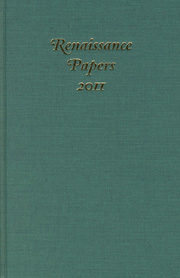Book contents
- Frontmatter
- Contents
- Dedication
- Walking, Waking, and the Armor of Light: Pauline Enactments in Henry IV, Part 1
- Costard's Revenge: Letters and Their Misdelivery in Love's Labour's Lost
- Productive Violence in Titus Andronicus
- Method in Marlowe's Massacre at Paris
- Ending Well: Mixed Genres and Audience Response in the London Theatrical Marketplace, 1604–06
- Birdlime: Sticky Entrapments in Renaissance Drama
- Sacrifice and Transcendence in Sir Philip Sidney's Astrophil and Stella
- The Quest for Certainty in Fulke Greville's A Treatie of Humane Learning
- Traces of the Masque in George Herbert's The Church
- Una Trinitas: Una and the Trinity in Book One of The Faerie Queene
- Reconsidering the 1599 Bishops' Ban on Satire
- Robert Bellarmine the Censor and Early-Modern Humanism
Ending Well: Mixed Genres and Audience Response in the London Theatrical Marketplace, 1604–06
Published online by Cambridge University Press: 05 April 2013
- Frontmatter
- Contents
- Dedication
- Walking, Waking, and the Armor of Light: Pauline Enactments in Henry IV, Part 1
- Costard's Revenge: Letters and Their Misdelivery in Love's Labour's Lost
- Productive Violence in Titus Andronicus
- Method in Marlowe's Massacre at Paris
- Ending Well: Mixed Genres and Audience Response in the London Theatrical Marketplace, 1604–06
- Birdlime: Sticky Entrapments in Renaissance Drama
- Sacrifice and Transcendence in Sir Philip Sidney's Astrophil and Stella
- The Quest for Certainty in Fulke Greville's A Treatie of Humane Learning
- Traces of the Masque in George Herbert's The Church
- Una Trinitas: Una and the Trinity in Book One of The Faerie Queene
- Reconsidering the 1599 Bishops' Ban on Satire
- Robert Bellarmine the Censor and Early-Modern Humanism
Summary
William Shakespeare's All's Well That Ends Well is of uncertain date, but many scholars suggest it was written and performed by the King's Men around 1604– 06, speculation largely based on “invocations of God in the play, a habit . . . curtailed in 1606 by James's edict against ‘the great abuse of the Holy Name of God in stage plays,’” a few topical references, and similarities with Measure for Measure, which was performed at Court at the very end of 1604. Recently, Terry Reilly convincingly has tied All's Well That Ends Well to debate over the Court of Wards and Liveries in Parliament in 1604, which “suggests a composition date after March 1604.” I assume the play was first performed in 1604–05.
In scholarly circles All's Well That Ends Well was consistently discussed as a “problem play” until the late 1980s or 1990s, when an emphasis on the similarities between its dark and uncomfortable elements and those of other Shakespearean comedies became more common. Nevertheless, that Shakespeare was testing the limits of genre as he was writing All's Well That Ends Well is a persistent part of the narrative of the Bard's professional trajectory.
- Type
- Chapter
- Information
- Renaissance Papers 2011 , pp. 53 - 64Publisher: Boydell & BrewerPrint publication year: 2012



